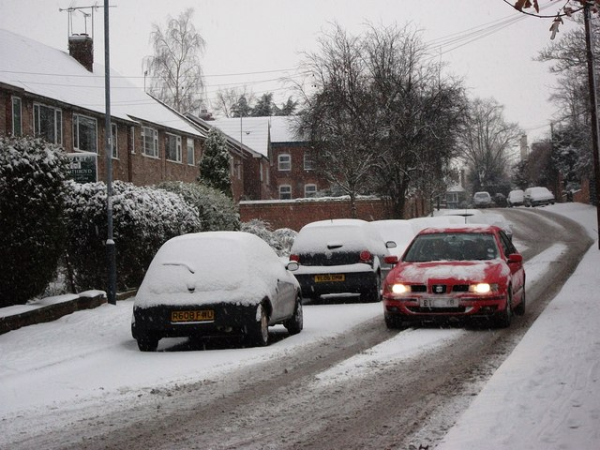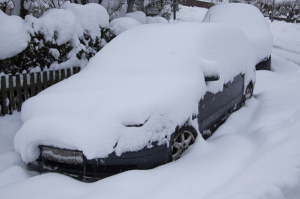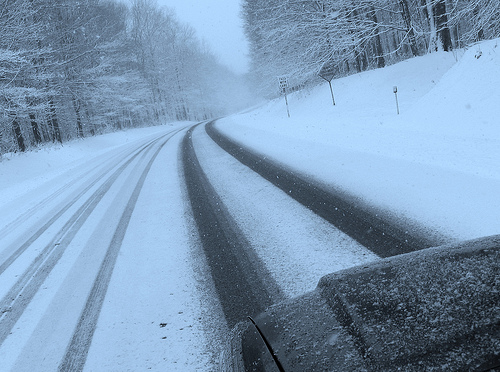
In the first part of our winter driving series, we gave you some advice for winterizing your vehicle. Now that your vehicle is ready for your road trips, here are some tips to keep in mind when driving to your wintery destinations:
1. Pull over or don’t go out at all:
The single best advice for driving in bad winter weather is not to drive at all! However, if you must be on the road, check the weather, road conditions and traffic – and give yourself extra time to reach your destination. If it’s snowing, try not to go out until the snow plows and sanding trucks have had a chance to do their thing. If you’re already out on the road, find a safe spot to pull over and wait until the weather passes or calms.
2. Control your space and speed:
Think back to those driver’s ed days with your instructor (ever so calmly) reminding you to slow down and to stop tailgating – and with good reason. If drivers would simply keep their distance from other vehicles and slow down, many snow and ice accidents could be prevented. Typically, if you can cut your speed in half in treacherous conditions, you can break or slow about four times faster. When it comes to following other vehicles, AAA recommends increasing your following distance to 8-10 seconds (dry pavement following distance is 3-4 seconds). That way if you need to stop, you’ll have a little extra leeway.
3. Shut off cruise control:
Sure, cruise control prevents you from getting leg fatigue, helps avoid speeding tickets and is great on long trips, but driving with it on in bad winter weather conditions can be very dangerous. If your vehicle hydroplanes or skids, it will accelerate and rapidly spin the wheels since it will be trying to maintain a constant speed.
4. Forget about cutting corners:
We’ve all done it. You’re freezing, in a rush, or just plain don’t feel like cleaning off your car – so you  get a little lax – perhaps leave a window (or two!) unclean or hope the snow will just blow off the hood of your car. Not a good idea! Take the time to clean off your hood, trunk, lights and windows and you’ll be happy you did. Snow left on these areas increases the possibility that your visibility (or others’ visibility) will be negatively affected. Also, before getting underway, start your vehicle and turn the heater on for a few minutes before using the defroster – this will prevent moisture from fogging the windshield.
get a little lax – perhaps leave a window (or two!) unclean or hope the snow will just blow off the hood of your car. Not a good idea! Take the time to clean off your hood, trunk, lights and windows and you’ll be happy you did. Snow left on these areas increases the possibility that your visibility (or others’ visibility) will be negatively affected. Also, before getting underway, start your vehicle and turn the heater on for a few minutes before using the defroster – this will prevent moisture from fogging the windshield.
5. Remember what you learned in Driver’s Ed:
It’s especially important to keep your gas tank above half-full at all times in the winter. Condensation can build up in a near-empty gas tank in extremely cold temperatures, which can cause fuel line freeze-up and no-start conditions.
6. Know what to do if you slide:
First and foremost, don’t panic! If your rear wheels are skidding, turn in the direction of the skid. So if your backend goes left, you want to turn left (and vice versa). If your front wheels are skidding, take your foot off the gas and shift to neutral – but don’t try to steer immediately. Once you start to regain control, steer in the direction you want to go, put the transmission back in “drive” (or release the clutch) and accelerate gently. Note: this is not second nature for many people and may require some practice. Consider sharpening your winter weather driving skills by practicing in an empty, snowy parking lot in full day light.
7. Master the art of braking:
In wet/slippery conditions, give yourself extra room and use the ball of your foot to apply gentle, steady pressure on the brake pedal (resist the urge to slam on your brakes!). If you have an Antilock Brake System (ABS), do not pump the pedal or remove your foot from the brake. On the other hand, if you don’t have an ABS System, the best way to stop is threshold braking – use the ball of your foot to apply firm, steady pressure on the brake pedal to the “threshold” of locking your brakes. Note: Keep your heel on the floor to avoid locking – once your heel leaves the floor, you’re using your thigh muscles instead of your ankle which are incapable of finer control.
8. Take it easy on hills:
Your first instinct might be to apply extra gas on snow covered hills, but this will just start your wheels spinning. Instead, try to get a little inertia going before you hit the hill to help carry you to the top (don’t stop!). As you reach the peak of the hill, reduce your speed and go down it as slow as you can.
9. Do one thing at a time:
 Many of us pride ourselves on our multitasking skills, but there is a time and place for everything! Trying to do two things at once when the roads are slippery – such as braking and turning – can reduce your control. For instance, brake only in a straight line prior to a turn when your vehicle is traveling straight.
Many of us pride ourselves on our multitasking skills, but there is a time and place for everything! Trying to do two things at once when the roads are slippery – such as braking and turning – can reduce your control. For instance, brake only in a straight line prior to a turn when your vehicle is traveling straight.
10. Don’t let your guard down:
Many drivers mistakenly believe that 4WD and AWD systems make them invincible in bad weather. Not true! Generally, 4WD and AWD systems provide extra traction when accelerating, but provide no extra advantage when braking or cornering.
11. Know what to do if you’re stranded:
An emergency road kit and travel first aid kit can go a long way in helping you stay safe and getting you back on the road quicker. Also, make sure you have all your membership cards handy, such as road assistance and travel assistance, depending on what type of emergency you encounter.
Have you ever found yourself in a slippery situation on a winter road trip? Leave your comments below – we’d love to hear your stories!


